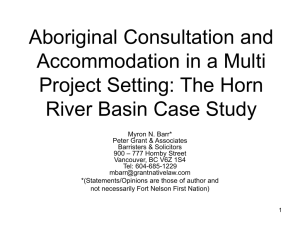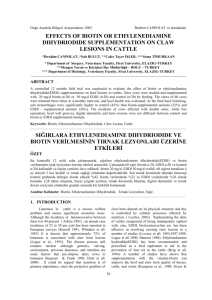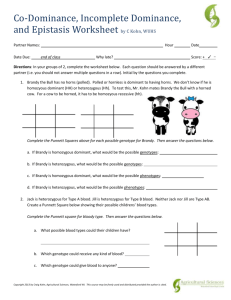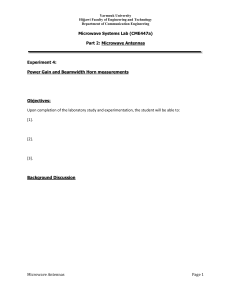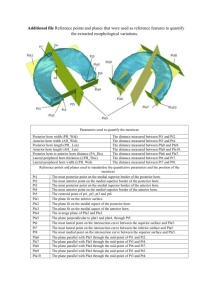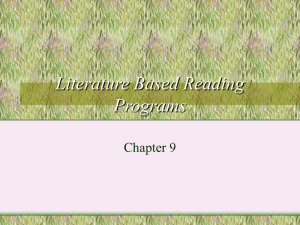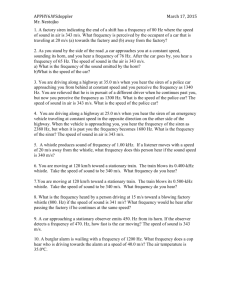Histological and physical assessment of claw horn quality in calves
advertisement
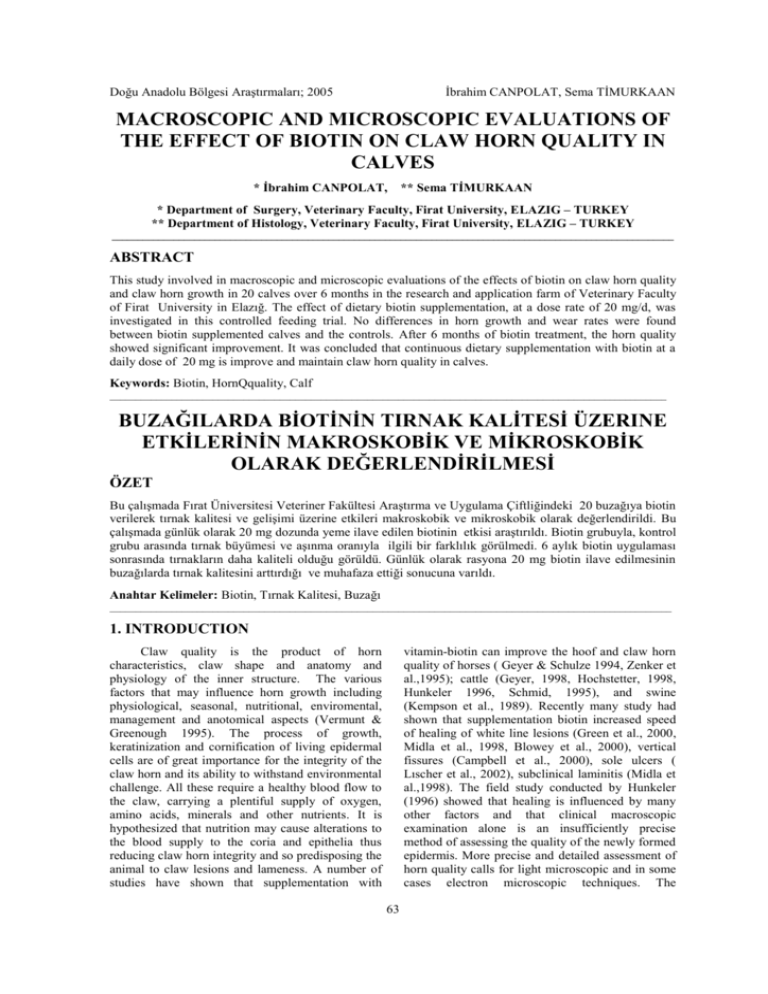
Doğu Anadolu Bölgesi Araştırmaları; 2005 İbrahim CANPOLAT, Sema TİMURKAAN MACROSCOPIC AND MICROSCOPIC EVALUATIONS OF THE EFFECT OF BIOTIN ON CLAW HORN QUALITY IN CALVES * İbrahim CANPOLAT, ** Sema TİMURKAAN * Department of Surgery, Veterinary Faculty, Firat University, ELAZIG – TURKEY ** Department of Histology, Veterinary Faculty, Firat University, ELAZIG – TURKEY _____________________________________________________________________________________________________________ ABSTRACT This study involved in macroscopic and microscopic evaluations of the effects of biotin on claw horn quality and claw horn growth in 20 calves over 6 months in the research and application farm of Veterinary Faculty of Firat University in Elazığ. The effect of dietary biotin supplementation, at a dose rate of 20 mg/d, was investigated in this controlled feeding trial. No differences in horn growth and wear rates were found between biotin supplemented calves and the controls. After 6 months of biotin treatment, the horn quality showed significant improvement. It was concluded that continuous dietary supplementation with biotin at a daily dose of 20 mg is improve and maintain claw horn quality in calves. Keywords: Biotin, HornQquality, Calf ____________________________________________________________________________________________________________ BUZAĞILARDA BİOTİNİN TIRNAK KALİTESİ ÜZERINE ETKİLERİNİN MAKROSKOBİK VE MİKROSKOBİK OLARAK DEĞERLENDİRİLMESİ ÖZET Bu çalışmada Fırat Üniversitesi Veteriner Fakültesi Araştırma ve Uygulama Çiftliğindeki 20 buzağıya biotin verilerek tırnak kalitesi ve gelişimi üzerine etkileri makroskobik ve mikroskobik olarak değerlendirildi. Bu çalışmada günlük olarak 20 mg dozunda yeme ilave edilen biotinin etkisi araştırıldı. Biotin grubuyla, kontrol grubu arasında tırnak büyümesi ve aşınma oranıyla ilgili bir farklılık görülmedi. 6 aylık biotin uygulaması sonrasında tırnakların daha kaliteli olduğu görüldü. Günlük olarak rasyona 20 mg biotin ilave edilmesinin buzağılarda tırnak kalitesini arttırdığı ve muhafaza ettiği sonucuna varıldı. Anahtar Kelimeler: Biotin, Tırnak Kalitesi, Buzağı _____________________________________________________________________________________________________________ 1. INTRODUCTION Claw quality is the product of horn characteristics, claw shape and anatomy and physiology of the inner structure. The various factors that may influence horn growth including physiological, seasonal, nutritional, enviromental, management and anotomical aspects (Vermunt & Greenough 1995). The process of growth, keratinization and cornification of living epidermal cells are of great importance for the integrity of the claw horn and its ability to withstand environmental challenge. All these require a healthy blood flow to the claw, carrying a plentiful supply of oxygen, amino acids, minerals and other nutrients. It is hypothesized that nutrition may cause alterations to the blood supply to the coria and epithelia thus reducing claw horn integrity and so predisposing the animal to claw lesions and lameness. A number of studies have shown that supplementation with vitamin-biotin can improve the hoof and claw horn quality of horses ( Geyer & Schulze 1994, Zenker et al.,1995); cattle (Geyer, 1998, Hochstetter, 1998, Hunkeler 1996, Schmid, 1995), and swine (Kempson et al., 1989). Recently many study had shown that supplementation biotin increased speed of healing of white line lesions (Green et al., 2000, Midla et al., 1998, Blowey et al., 2000), vertical fissures (Campbell et al., 2000), sole ulcers ( Lıscher et al., 2002), subclinical laminitis (Midla et al.,1998). The field study conducted by Hunkeler (1996) showed that healing is influenced by many other factors and that clinical macroscopic examination alone is an insufficiently precise method of assessing the quality of the newly formed epidermis. More precise and detailed assessment of horn quality calls for light microscopic and in some cases electron microscopic techniques. The 63 Doğu Anadolu Bölgesi Araştırmaları; 2005 İbrahim CANPOLAT, Sema TİMURKAAN objective of the present study was to compare claw horn quality assessed by macroscopic and histological examination, in the biotin-supplemented calves and control groups. within groups. There were no significant differences between the growth and wear rates of the claw horn of the supplemented and non-supplemented groups of calves (Table 1 and 2). Table 1: Growth rates of claw horn of calves 2. MATERIALS AND METHODS Growth rates (mm/months) Twenty Swiss Brown calves and twenty control were used. In addition to their normal daily ration, 20mg of biotin (Vitamin-H,Merck), giving a therapeutic dose of 20mg of biotin per day to 20 calves. The claws of the calves were individually examined from 30 to 210 days of age. The conditions of the hooves were recorded. The horn growth rate was calculated using the method described by Johnston and Penny (1989). Following measurements were taken. From the tattoo to the horizontal groove at the junction with each vertical groove (a). From the horizontal groove along each vertical groove to the edge of the weight-bearing surface (b). The distance between the first and subsequent horizantal grooves (c). Measurement were made at three months intervals. The extent of growth was calculated as the previous value of ‘a’, subtracted from the current value of ‘a’: (a2-a1). When a horizantal groove had been cut, the growth was calculated as a2-(a1-c). The extent of wear was calculated as the current value of ‘b’ substracted from the previous value of ‘b’:(b1-b2). When a horizantal groove had been cut, the wear was calculated as (b1+c)-b2. Growth and wear rates were calculated by dividing these values by the intervals in months, between the pairs of measurements. Control Biotin supplemented calves Growth Rates (mm/month AVG days) PVG AVG PVG 9.76 ± 1.5 10.5± 1.2 10.0± 1.3 10.3 ± 1.4 AVG: Anterior vertical groove. PVG: Posterior vertical groove Table 2: Wear rates of claw horn of calves Control Wear rates (mm/months) Biotin supplemented calves Growth AVG(mm/month days) PVG AVG PVG Rates 6.1 ± 1.4 6.2 ± 1.2 6.2± 1.3 6.0±1.2 AVG: Anterior vertical groove. PVG: Posterior vertical groove Histological assessment of the horn showed an overall improvement in horn quality in the biotin group. The improvement in the light microscopic appearance of the horn structure was manifest especially in the form of compact horn tubules and well-ordered intertubular horn. The horn cell and cell to cell adhesion in the horn cell cluster was also adequate. All horn tubules were dilated (Fig 1 and 2). Fig 2: Light microscopic appearance horn sample of control group. Arrows, horn tubules (cylindri cornei) (H.E.X 25) Fig 1: Calf foot showing points at which measurement were made. On months 3 to 6 of the study, horn sample was taken from each animal for histological examination. Horn samples were frozen at -20 C until further processing. The sections were cut with freezing microtome. The samples were fixed in 10% formalin solution, and then stained by in haemtoxylin-eosin (HE). 3. RESULT The growth rates at the anterior and posterior vertical grooves were compared between groups and Fig 3: Light microscopic appearance dilated horn tubules of biotin group. (H.E.X 25) 64 Doğu Anadolu Bölgesi Araştırmaları; 2005 İbrahim CANPOLAT, Sema TİMURKAAN Geyer, 1998; Hochstetter, 1998). Horn quality can be assessed by macroscopic examination, material testing methods, or light-microscopic examination of horn structure (Geyer, 1998). Macroscopic examination is only able to detect superficial changes in the newly formed epidermis. Therefore, any influence of biotin on horn quality cannot be assessed adequately, if at all, by macroscopic examination after 50 days, but only after longer periods (Hunkeler, 1996; Hochstetter, 1998). Improvement in horn quality can also be assessed by measurement of tensile strength (Schmid, 1995), however with this method significant changes in distal sole horn have been found only 4 months after the start of biotin administration. In the present study, histological examination of claw horn was achieved at 120 and 210 days and found a significant improvement in horn structure as compared to control group. The horn cells were good and all horn tubules are dilated in the biotin treatment groups, which demonstrates that the horn cells were well neurished. 4. DISCUSSION There is some evidence that biotin supplementation of clinically healty young animal can help to maintain horn integrity (Geyer, 1998, Hochstetter, 1998, Hunkeler 1996 Simmins&Brooks 1988). The biotin should be continuously supplemented at the full dosage in horses with severe hoof horn alterations (Geyer & Schulze, 1994). Biotin treatment animals had a 15% higher growth rate of hoof horn and 15% more hoof growth at the midline dead centre, after 5 months of biotin supplementation compared to control in ponies ( Reilly et al.,1998). On the other hand, biotin supplementation should not be expected to result in an increased rate of horn growth sows (Johnston and Penny 1988). In this study, no differences in horn growth and wear rates were found between biotin supplemented calves and the controls. Rather, the principal effect of biotin is an improvement in horn quality (Reilly &Brooks, 1990; Geyer & Schulze, 1994; Josseck et al.,1995; 5. REFERENCES 1. GEYER, H. (1998). The influence of biotin on horn quality of hooves and claws. Proceedings of 10th International Symposium on Lameness in Ruminants, Lucerne, 192. 2. GEYER, H. & SCHULZE, J. (1994). The longterm influence of biotin supplementation on hoof horn quality in horses. Schweizer Archiv fuÈr Tierheilkunde 136. 3. 4. 5. 6. GREEN, L. E.,HEDGES, V. J., O'CALLAGHAN, C., BLOWEY, R. W.,HOCHSTETTER, T. (1998). Die HornqualitaÈt der Rinderklaue unter Einfluss einer Biotinsupplementierung. Veterinary Medicine Thesis, Free University, Berlin. HUNKELER, A. (1996). Einfluss von Biotin auf die Heilung von KlauengeschwuÈren beim Rind. Veterinary Medicine Thesis, University ZuÈrich. 7. MIDLA, L. T., HOBLET, K. H., WEISS, W. P. & MOESCHBERGER,M. L. (1998). Supplemental dietary biotin for prevention of lesions associated with aseptic subclinical laminitis (pododermatitis aseptica diffusa) in primiparous cows. American Journal of Veterinary Research 59,733-8. 8. REİLLY JD, COTTRELL DF, MARTİN RJ, CUDDEFORD DJ. (1998), Effect of supplementary dietary biotin on hoof growth and hoof growth rate in ponies: a controlled trial. Equine Vet J Suppl. (26):51-7. 9. SCHMID, M. (1995). Der Einfluss von Biotin auf die Klauenhornqualita Èt beim Rind. Veterinary Medicine Thesis,University ZuÈrich. 10. SİMMİNS PH, BROOKS PH. (1988) Supplementary biotin for sows: effect on claw integrity.Vet Rec. 30;122(18):431-5. JOHNSTON AM, PENNY RH. (1989) Rate of claw horn growth and wear in biotinsupplemented and non-supplemented pigs.Vet Rec. Aug 5;125(6):130-2. 11. VERMUNT JJ & GREENOUGH PR(1995). Structural charesteristics of the bovine claw: horn growth and wear, horn hardness and claw conformation. Brit Vet J 151(2)157-80 JOSSECK, H., ZENKER, W. & GEYER, H. (1995). Hoof horn abnormalities in Lipizzaner horses and the effect of dietary biotin on macroscopic aspects of hoof horn quality. Equine Veterinary Journal 27, 175±82. 12. ZENKER, W., JOSSECK, H. & GEYER, H. (1995). Histological and physical assessment of poor hoof horn quality in Lipizzaner horses and a therapeutic trial with biotin and a placebo. Equine Veterinary Journal 27, 183-91. 65


